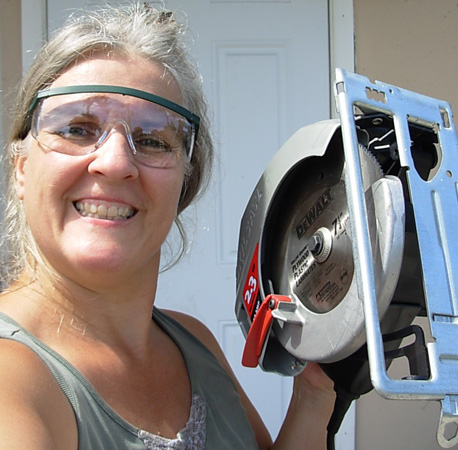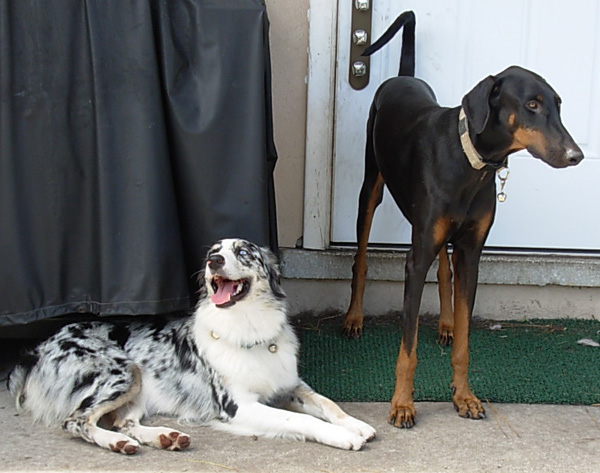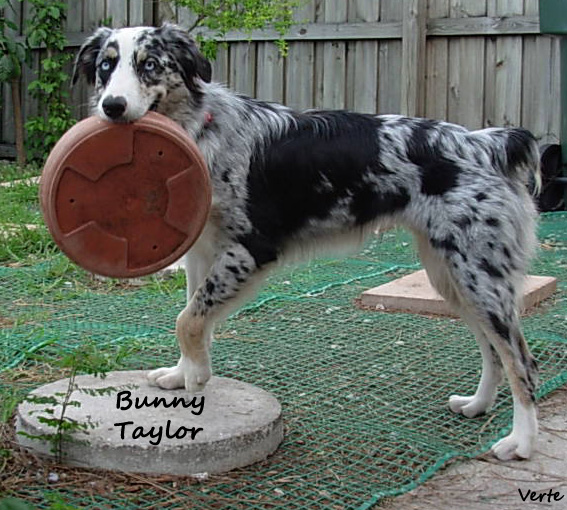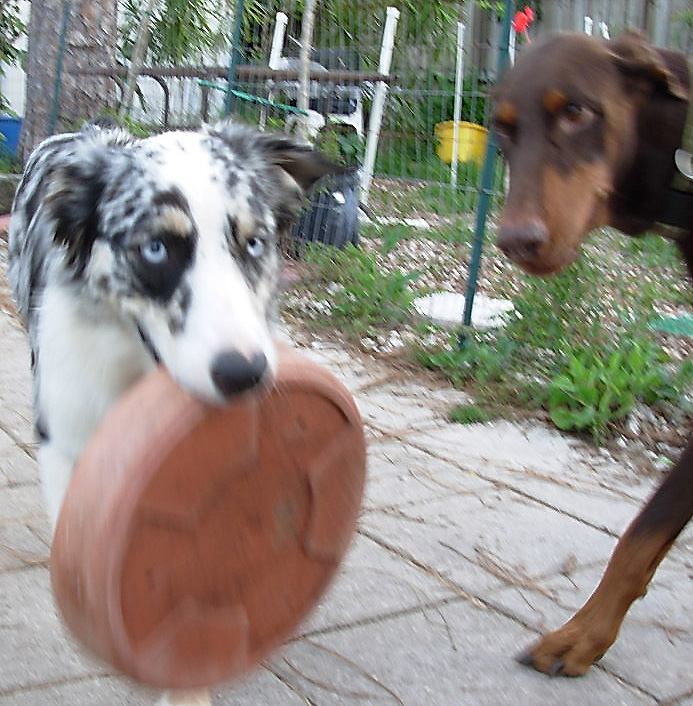The Anti-Cesar Millan
This article appeared on page CM – 5 of the San Francisco Chronicle
Ian Dunbar’s been succeeding for 25 years with lure-reward dog training; how come he’s been usurped by the flashy, aggressive TV host?
Louise Rafkin
Sunday, October 15, 2006
It’s late afternoon at Point Isabel, prime time at the Bay Area’s popular off-leash dog park, and the man some call the most innovative in the field of dog training weaves unnoticed through the two- and four-legged throngs. No one recognizes the slight, snow-haired man dressed in Berkeley-esque traveler’s clothes (well-pocketed shirt and cargo pants) as Dr. Ian Dunbar, the man who wrote the book — rather, six books — on pet dog training and the guy who developed one of the earliest puppy-training courses in the country. Dunbar is 59, and though he’s been away from his native England for decades (since 1971), he carries the air of an English gentleman. Occasionally British colloquialisms slip into conversation. “I was gob-smacked!” is how he explains his recent shock over a case of dog-owner ignorance.
With an eager border collie obsessively dropping a ball at his feet, Dunbar scans the Point Isabel regulars. It’s hard to imagine he’s not passing judgment on particular behaviors, but mostly he smiles at the four-legged passers-by. Thirty-five years of studying dogs has not dulled him to simple joys.
“Bay Area dogs are so cool, so friendly and polite,” he says. When a brown fluff ball approaches jauntily and sniffs his pant leg, he genuinely gushes. “What a cute puppy!” Then an incessant barker demands attention. “We’ve heard,” he says firmly to the lab. “Haven’t you got anything else to say?”
Though they probably don’t know it, Dunbar’s training methodology has probably influenced the pet-owner relationship of almost everyone here at the park. He says he was the first to preach the once revolutionary idea of training puppies off leash (formerly only those six months and older were thought trainable) and also says he was the first to stuff food into a Kong (the conical shaped rubber chew toy and object of desire of most chewing-age puppies), thus saving table legs and Italian loafers worldwide. More important, his methods and theories have saved dogs’ lives. Dog training is his passion, but it’s not simply because he finds a well-trained pet a thing of beauty.
Training, he says, saves dogs’ lives.
“Without training, the life of a puppy is predictable: chewing, soiling the house, digging up the garden, followed by a trip to the shelter where, if it’s lucky, it gets another try,” he says, wearily. “Without training, that dog will be dead in less than a year.”
There is a quiet battle being fought in dog-training circles, and Dunbar, though he didn’t pick the fight, represents one side. The mild, very mannered Dunbar is armed with degrees and scientific study: a veterinary degree and a Special Honors in physiology and biochemistry from the Royal Veterinary College of London University, a doctorate in animal behavior from the psychology department of UC Berkeley and a decade of research on the olfactory communication, social behavior and aggression in domestic dogs. All this, plus decades of dog-training experience.
Impressive, yes, but his opponent in this training controversy is backed by big business, Hollywood celebrity and, even worse, some say, the power of charisma. Cesar Millan, a.k.a. the Dog Whisperer, has his own television series on the National Geographic Channel and is churning out a burgeoning enterprise of videos and books. The subject of a recent New Yorker profile by Malcolm Gladwell, Millan is often photographed on high-tech in-line skates, leading a pack of pit bulls, rottweilers and German shepherds. The sexy Millan’s dog-handling credentials include an upbringing on a Mexican farm, an “uncanny gift for communicating with dogs” and his Dog Psychology Center in Los Angeles. There, with a pack of 50 dogs, he rehabilitates wayward canines.
Besides foreign roots, there is little these two men share, except, as Dunbar points out, the bedrock belief that all dogs can and should be trained. If this were a dogfight, it would be the unlikely match between a pit bull and a border collie — unlikely, because those who know dogs know the border collie would simply leave. In this case, however, those watching the fight keep pushing the smart dog back in the ring. Top dog trainers nationwide have expressed dismay that Millan is the current face of dog training, and most say that Dunbar should be the one with the empire. It’s a perennial conflict in training discourse. Are results best achieved through rewarding good behavior or punishing bad?
Millan subscribes loosely to the idea of the pack, a dogs-as-wolves theory that had long ago fallen out of favor with many trainers. Touting dominance by pet owners, and the dictate to create “calm submission” in their charges, Millan says owners are essentially pack leaders. “I teach owners how to practice exercise, discipline and then affection, which allows dogs to be in a calm, submissive state,” he explains when asked to clarify. “Most owners in America only practice affection, affection, affection, which does not create a balanced dog.
“Training,” says Millan, “only teaches the dogs how to obey commands — sit, roll over — it does not have anything to do with dog psychology.”
In his recent best-seller, “Cesar’s Way,” Millan writes that there are only two positions in a relationship, leader or follower. “I work with dogs all the time that are trained but not balanced.” Included in Millan’s repertoire is a snappy touch that he claims mimics a corrective response by pack leaders, “alpha rollovers” (forcibly making a dog show its belly), and submission to being rear sniffed.
“Never heard of that,” says Dunbar when asked about bottom sniffing, but he is loath to completely discount Millan. Indeed, both trainers advocate any techniques that are humane and work for the dogs and the owner.
“He has nice dog skills, but from a scientific point of view, what he says is, well … different,” says Dunbar. “Heaven forbid if anyone else tries his methods, because a lot of what he does is not without danger.” “Don’t try this at home” messages are flashed throughout the show, and in September, the American Humane Association requested that the National Geographic Channel stop the show immediately, citing Millan’s training tactics as “inhumane, outdated and improper.”
Writer Mark Derr, in a recent New York Times editorial, went as far as to call Millan a “charming, one-man wrecking ball directed at 40 years of progress in understanding and shaping dog behavior.”
Nicholas Dodman, program director for the Animal Behavior Clinic at the Cummings School of Veterinary Medicine at Tufts University and author of “Dogs Behaving Badly,” goes even further. He calls Millan’s techniques “abuse.” A TV producer claiming his dog was injured while training at the Dog Psychology Center is reportedly suing Millan.
While distaste for Millan might be growing, Dunbar focuses on discounting the myths such training ideas foster. Dogs aren’t wolves, Dunbar says, generations of evolution separate the two animals. “Learning from wolves to interact with pet dogs makes about as much sense as, ‘I want to improve my parenting — let’s see how the chimps do it!’ ”
Dunbar claims compliance, the goal of all dog training, is most often achieved through positive training methods. His lure-reward methods — using treats and praise — have an even higher rate of success if there is puppy socialization. Indeed, puppies put Dunbar on the dog-training track. In 1981, after buying an 8-week-old malamute, Dunbar sought a puppy class. He cast out as far as Sacramento and Carmel but came up with nothing. At the time, common understanding was that dogs couldn’t be trained until they were 5 or 6 months old, but from his studies, Dunbar knew dogs were learning behaviors long before that. Though his academic interest was in dog olfactory research and sexuality (“dog humping,” he shorthands), Dunbar soon found himself venturing out of the ivory tower. He found that he enjoyed educating pet owners and began developing a training program using positive feedback, games and treats.
Sirius Dog Training, as Dunbar called it, showed proven positive results from early off-leash training. His classes, and the resulting video, were embraced by trainers and owners alike. Many say Sirius spurred the demise of punitive, punishment-based training that was the vogue after World War II. In 1993, Dunbar founded the Association of Pet Dog Trainers whose mission is to promote better training through education.
The return to dominance training such as Millan’s, Dunbar says, is a disservice to dogs more than anything else. Though Millan gets results, Dunbar notes that most people don’t have Millan’s strength or skill, and even fewer keep dozens of dogs. “I teach methods that a supervised 4-year-old can use,” Dunbar says. Having been called as a witness in high-profile Bay Area bite trials — he was one of a team who evaluated one of the dogs involved in the deadly attack on Diane Whipple in 2001 — he is all too familiar with the violent underbelly of dog aggression. Fear, he underscores, doesn’t train a reliable dog.
Claudia Kawczynska, editor of Bark magazine, is one of Dunbar’s many fans. “It’s irritating to see Millan treated as the expert. Ian is an animal behaviorist with decades of experience,” she says, “He should be where Millan is.” Kawczynska likens the Millan cult of personality and popularity to the anti-science, anti-academic sentiment she sees prevalent in American culture and politics. “Millan lived on a farm, so what? He’s good looking, but he’s not smart about dogs. It seems people don’t want their experts to be educated.”
Dunbar refuses to comment on whether his lack of profile is due to his weighty credentials, though a Millan fan on Gladwell’s blog says the backlash against the Dog Whisperer is “because Malcolm had written about the unschooled Millan rather than a string of PhDs that the average person has never heard of — and never will.”
Jean Donaldson, director of dog training at the SFSPCA and author of “Culture Clash,” a book about the human-dog relationship, views the history of dog training in pre- and post-Dunbar eras. “Ian is the man,” she says. “He revolutionized the field.” She, too, thinks Millan is tapping into something deeper in the current culture — and his machismo is only part of it. “It’s a backlash against political correctness,” she says. “People are angry and life is frustrating and [when] someone tells them it’s all about dominating something smaller and weaker? They’ll go for that.”
“Dunbar puts training in the owner’s hands,” says Aishe Berger, co-owner of SF Puppy Prep, a puppy day care facility that promotes Dunbar’s theory of early socialization. “His methods are based on science and learning theory, not the kind of ‘magic’ touted by the gurulike Millan.”
But if the magic works, who wouldn’t want magic?
There’s the catch: Since Millan’s program has gained popularity, Donaldson reports, the SPCA has been flooded with calls from confused and frustrated owners who want her to decipher — and give them the scoop — on Millan’s “mysterious pinch.”
Dr. Patricia McConnell, author of “For the Love of a Dog: Understanding Emotion in Your Best Friend” and the animal behaviorist on Animal Planet’s “Petline,” goes as far as to say that Millan has put dog training back 20 years. “Dunbar is a world authority,” she says, “and he should be the one with the celebrity.”
Dunbar doesn’t argue with that. Though he hosted five years of a TV training show in England, “Dogs With Dunbar,” Hollywood never bit on it, or on his other ideas, several of which are tinged with the odor of ever-popular reality TV. “Shelter Dog Makeover” (“We’d groom them, train them and find them a new home!”) and “Train That Dog” (trainers compete to train a dog to do various tricks and obedience trials in the least amount of time) were two he thought most promising. Dunbar says Animal Planet mucky-mucks said they turned tail at his foreign accent, but he doubts that was the real truth. After all, the channel vaulted to popularity with hosts from Down Under.
As for books, of which he has sold hundreds of thousands, his first experience in publishing colored his view of New York representation. Dozens of publishers turned his first book down, but the one who finally came through soured him to New York publishing. He bemoans the editing that was done on his work, and the publishing experience itself disappointed him. The numbers of books sold, he said, never really added up to what was reported — and what he knew himself had moved.
Some local experts lament Dunbar’s failure to go mainstream, citing his unwillingness to lose control over every aspect of his work, including editing.
For himself, Dunbar has almost given up on the megamedia, though he says he could name 20 excellent and attractive trainers who could make a show fly. He’s got other ideas. One groups experts from many fields — a psychologist, a puppy trainer, a hostage negotiator and a grandmother with the wisdom of life experience — who would be presented with a problem such as a husband who won’t come home from the bar after work. Each expert would devise a plan and the favorite would be implemented on the show.
“All training is negotiation,” Dunbar says, “whether you’re training dogs or spouses.” Indeed, a recent article in the New York Times titled “What Shamu Taught Me About a Happy Marriage” hit a nerve when the author, Amy Sutherland, who writes on exotic animal training, admitted using training techniques on her partner. Dunbar agrees with Sutherland’s premise that training is training is training. “You can instill fear in your kids and get them to mind, but they won’t function better in the world and your relationship will suffer greatly,” he adds.
“Problems that need correcting are the thin end of the wedge,” he says, “with dogs and people.” It doesn’t take much, he claims. A smile, a kind word. “You don’t have to give M&M’s all the time. People — and dogs — are dying to be trained.”
Dunbar has a 23-year-old son, Jamie, a wooden dory river guide, with his first wife, Mimi, and says his family configuration is “very Berkeley” — both his current wife (and former dog-sitter), Kelly Gorman, and his ex-wife are on friendly terms. Gorman, also a trainer and a founder of Open Paw, an international humane animal education program for pet owners and shelters, has done a good job of training him, he reports. Currently in the midst of giving up his much-loved cigars, Dunbar muses that Gorman is actually the better trainer of the pair. Two of the couple’s three dogs are hers: Dune, an American bulldog, and Ollie, a rescue from Chicago Heights Humane Society. The third, Claude, a 110-pound rottweiler-coon-hound mix from the SFSPCA, is what Dunbar calls a “special needs” case. “We train him one day, and the next day we start over again. He’s more than not bright.”
Despite a lack of publicity, Dunbar’s recent talk on dog aggression at a local bookstore brought out a full house of fans, many with pen and paper at the ready. With little sign of any training controversy, there is, however, evidence of Dunbar’s status as local cult leader by the standing-room-only crowd. During his hourlong lecture, Dunbar explained the physiology of dog aggression in a way that showcased his British humor. He easily charmed the audience with jokes and witticisms; his dog impersonations, including a rear view, full-bottom wiggle, kept the audience enthralled and grinning. Though every move he made was carefully watched and met with nods of knowingness, at times he looked a tad silly. He giggled, he gushed and he panted. Having just returned from Tokyo, he contorted his face in an impersonation of a Japanese dachshund. Could an American TV audience have embraced this kind of goofiness?
At the end of the hour, Dunbar had to leave to get ready for yet another seminar, this time in the Midwest, one of the few left to which he has committed. With 850 full-day seminars behind him, Dunbar is winding down touring. He’s considering living in southern France or traveling for pleasure, one of his passions. He’s passing his baton to others who will no doubt continue the struggle over dog-training particulars. But without Dunbar’s engagements to drive the sales of his training guides and videos, it’s easy to imagine that flashier, more commercial materials will easily eat up his market. Whether those will reflect his ideas — or Millan’s — it’s hard to say.
At least half the audience still has questions for the expert, but despite raised hands, Dunbar uses the last minute to reiterate his training philosophy. “We need to thank our dogs for being good,” he says, launching into a wrap-up more spiritual than practical. “Every morning I give thanks for waking up — the alternative is not so good. Too often, we forget to be thankful.” Clearly, he’s from Berkeley, not Hollywood.
Louise Rafkin last wrote for the Magazine about her life as an undocumented worker.










